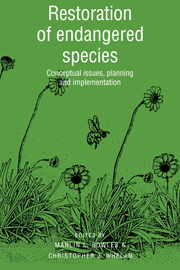Book contents
- Frontmatter
- Contents
- List of contributors
- Foreword
- Acknowledgments
- I Conceptual issues in restoration ecology
- 1 Organizational and managerial guidelines for endangered species restoration programs and recovery teams
- 2 Genetic considerations for plant population restoration and conservation
- 3 Managing genetic diversity in captive populations of animals
- 4 The relationship of rarity to plant reproductive biology
- 5 Experimental evidence for insect impact on populations of short-lived, perennial plants, and its application in restoration ecology
- II Restoration planning
- III Implemented restorations
- IV Synthesis and future directions: biology, politics and reality
- Taxonomic Index
- Subject Index
1 - Organizational and managerial guidelines for endangered species restoration programs and recovery teams
Published online by Cambridge University Press: 27 January 2010
- Frontmatter
- Contents
- List of contributors
- Foreword
- Acknowledgments
- I Conceptual issues in restoration ecology
- 1 Organizational and managerial guidelines for endangered species restoration programs and recovery teams
- 2 Genetic considerations for plant population restoration and conservation
- 3 Managing genetic diversity in captive populations of animals
- 4 The relationship of rarity to plant reproductive biology
- 5 Experimental evidence for insect impact on populations of short-lived, perennial plants, and its application in restoration ecology
- II Restoration planning
- III Implemented restorations
- IV Synthesis and future directions: biology, politics and reality
- Taxonomic Index
- Subject Index
Summary
Introduction
Endangered species recovery is always difficult, and biologists need to use the best tools, skills, and experience available. While the use of appropriate biological tools is essential for successful recovery, other factors are also indispensable. These include problem analysis and problem-solving strategies, organizational design, work group effectiveness, effectiveness of interpersonal relationships, and clarity and specificity of goals and objectives. Inadequacy in any of these factors may result in inefficiency and ineffectiveness of the recovery job; ultimately, the species may not be recovered! Professional biologists and managers readily recognize the biological dimensions of recovery work, but largely overlook or depreciate the value of organizational factors. Because of the urgency and the sense of finality inherent in recovery efforts, professionals would do well to attend to such factors.
In this chapter, we introduce some organization and management concepts and recommendations that can help the work of conservationists. Specifically, we 1) provide some background on organization designs and management processes that are useful in species recovery; 2) examine the endangered species task environment in organizational terms; 3) identify the task force/project team model as the most appropriate for recovery work; 4) describe the four functions of management—organizing, planning, leading, and controlling—in these teams; 5) examine task-oriented teams versus power-, role-, or people-oriented teams; 6) introduce a procedure to analyze problems and develop action plans; and 7) offer, in an appendix, a method for developing action plans.
- Type
- Chapter
- Information
- Restoration of Endangered SpeciesConceptual Issues, Planning and Implementation, pp. 9 - 33Publisher: Cambridge University PressPrint publication year: 1994
- 4
- Cited by



